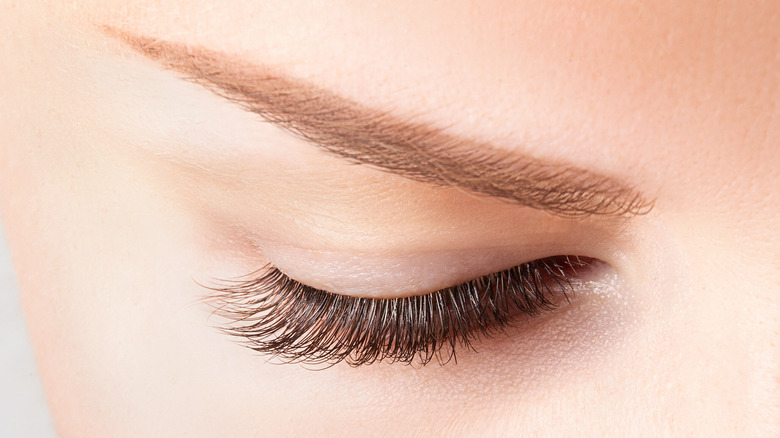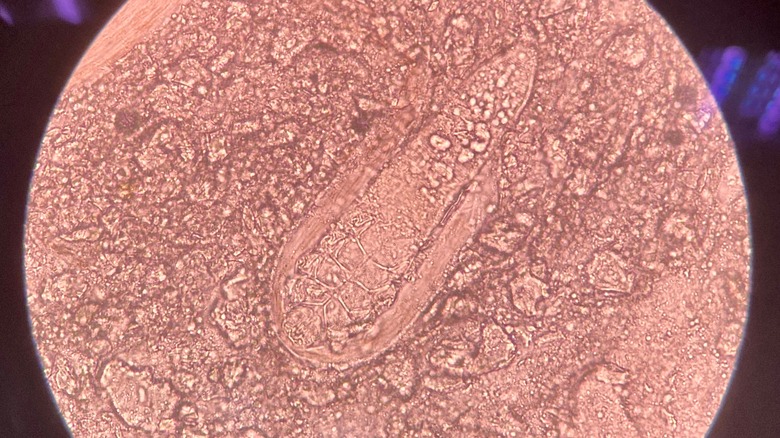Scientists Say These Creepy Creatures Are Colonizing Your Face
Did you know that there are microscopic organisms called demodex that live on our faces? According to Cleveland Clinic, these tiny mites are transparent in color and not visible to the naked eye. Demodex attach themselves to human hair, usually on the face, including eyelashes, cheeks, the forehead, and sides of the nose. But most people will never know that they are co-existing.
The thought of creepy crawlers living on your face might make your skin crawl (no pun intended!) but these microorganisms are mostly harmless. NPR reports that nearly every person alive has them, but you'd likely never know because they are too small to see with the human eye. Unless you experience side effects of demodex, you'll probably never know they're there. These critters are only about 0.3 millimeters long and scientists have to put them under a microscope to study them.
Interestingly, while these mites can attach to almost any part of the face with hair, these mites are also known as eyelash mites because they are so common in this area, per NPR. Here's what to know about the mites around your lashes.
The mites that live on your lashes
Research on what causes demodex mites to accumulate on eyelashes is ongoing and scientists are becoming more informed about these little creatures. According to Healthline, certain medical conditions can make a person more susceptible to eyelash mites, including alopecia, rosacea, HIV, inflammatory acne, and dermatitis. While demodex have been found to be living on nearly every person on the planet without issue, Cleveland Clinic reports that people who are immunocompromised are more susceptible to over-multiplication of these microscopic mites and could risk experiencing side effects from them.
Eyelash mites are generally harmless, but there are a handful of symptoms you can experience. WebMD reports that potential side effects include feeling like something is in your eye, blurry vision, tearing or watery eyes, and pain in or around the eye that could include itching or burning sensations. It is also possible that the edges of your eyelids may become red and crusty. If you are concerned about side effects, it is always recommended that you consult with your healthcare provider.
How to prevent them
An over-infestation of demodex is called demodicosis, and treatments include tea tree oil and an over-the-counter medication called Cliradex (via VeryWell Health). Cliradex is available in the forms of towelettes and foaming facial cleansers, and is typically suggested to be used twice a day for approximately six to eight weeks to clear eyelash mites. But you should always consult with your healthcare provider for specific instructions on how to clear demodex since every person's experience is different. Because demodex can lead to other eye conditions, including conjunctivitis and ingrown eyelashes, treatments for related conditions are often addressed in addition to the treatment of eyelash mites.
Prevention of demodex comes down to good hygiene and practices. Healthline recommends never sharing eye products, including mascara, eyeliner, eye shadow, and eye drops with others so that potential eyelash mites aren't spread from one person to another. It is also key to wash your face daily, preferably twice a day. When it comes to the eye area, it is best practice to stick with only water, but you can also use an eyelash brush and a baby shampoo to gently clean the area. If you wear makeup, stick to non-oily products, and use eyelash wipes every day.
How demodex can be beneficial
According to The Guardian, a 2022 study published in Molecular Biology and Evolution is the first of its kind to study the genome sequencing of demodex, discovering how many mites can live on a human host throughout the person's lifetime. From egg to death, individual demodex mites are believed to live for an average of three weeks. It takes approximately two weeks for a mite to become an adult, and researchers estimate that it lives for an additional week or two after reaching adulthood before dying. Using the average human life expectancy of 72.6 years, the study concluded that roughly 1,262 generations of demodex will exist on a human host throughout the person's lifespan. Since the number of mites on each person is different, there's no way to determine how many individual demodex mites will exist on a single person, but given that there will be approximately 1,200 generations of mites on a human host, the number must be pretty staggering.
Scientists are discovering that demodex mites might actually be helpful to their human hosts. Lead researcher Dr. Henk Braig of Bangor University in Wales and the National University of San Juan has said that the long history demodex has had with human hosts may point to these mites playing a beneficial role in keeping our pores unclogged, per The Guardian. So while demodex may choose to inhabit our hair follicles and oil glands, helping to clear our pores seems like a good symbiotic relationship to have with them!
Demodex may ultimately go extinct
Extinction of any species is never desirable, even if that species lives and mates within our skin. Despite the innovation of the 2022 study, not all of its conclusions were positive. Most worrisome is the discovery that demodex are at risk of extinction. The Guardian reports that these microscopic mites appear to be in the process of transitioning from parasites to internal symbionts, which means that they're becoming completely dependent on humans to continue their existence. The researchers of the study noted that when a species changes from a pathogen to a symbiont with a close host relationship, then a pathway to potential extinction is created.
Among several discoveries of demodex's genome, Dr. Braig and his team discovered that the microscopic mites are losing some of their genes that generate repair enzymes, meaning that they're losing the ability to fix physical damage to their DNA and heal themselves (via DownToEarth). Since demodex tend to stick with a single human host, inbreeding has caused a breakdown in their evolution. While not having mites on our skin may seem like a good thing, these microscopic partners feed off of human sebum, which is the waxy, oily substance produced within our pores, so there could be a lot of benefits that these tiny friends can offer. It's not yet known how the extinction of demodex can be prevented.





